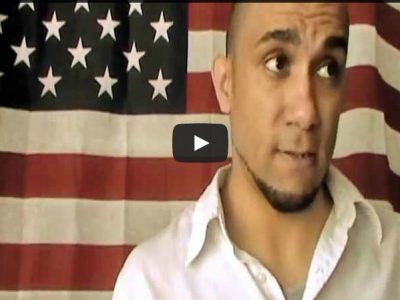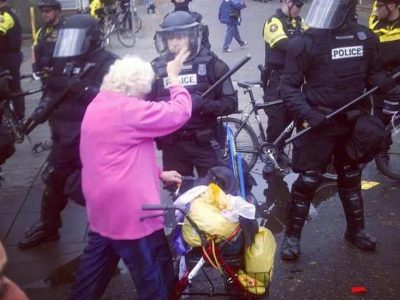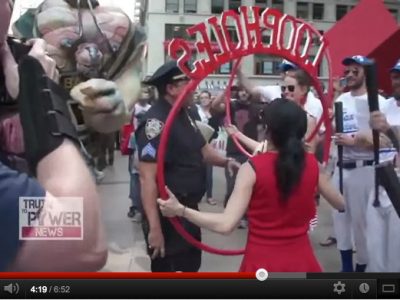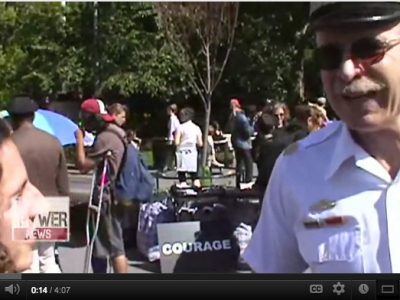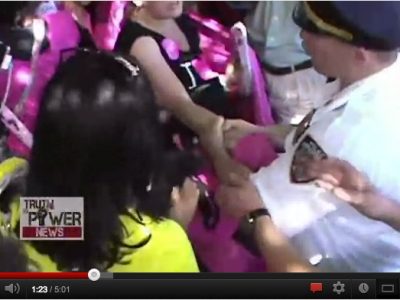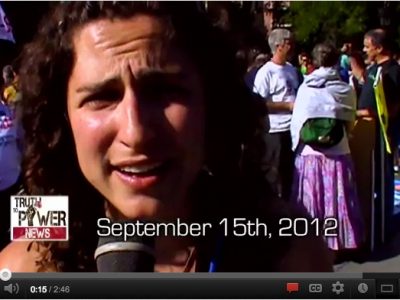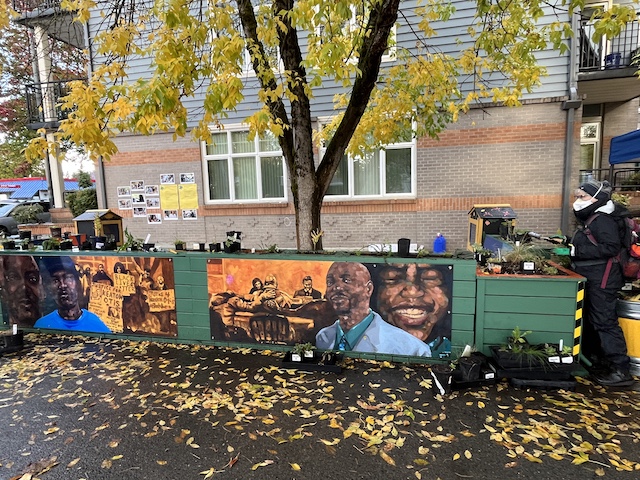
Story and photos by Pete Shaw
The monthly vigils for Keaton Otis, Fred Bryant, and all victims of police violence have always had a tension to them. There is the grim reality of why people have gathered on the corner of Northeast 6th and Halsey for over 15 years, recalling Otis, Bryant, and the many other lives taken too soon by police. Yet there is also a sense of celebration, however subdued. It is founded in a resilience and memory that pushes forward toward a more just future.
At 6 PM on October 12, 15 years and 5 months after the Portland police murdered Keaton Otis, and 15 years and 4 months after Otis’s father, Fred Bryant, began the vigils, over 70 people gathered at that fateful corner to dedicate the Keaton Otis Memorial Parklet. The balance leaned more than usual in the favor of celebration. Even the weather, predicted to bring heavy rains, seemed to join in to fete Otis and Bryant, nearly rendering gratuitous the four erected canopies
“Black commemoration is not merely nice, but necessary,” said Donovan Scribes, capturing the gravity of the moment. “It allows for power to be forged out of the proof of our existence and weave the necessary connections to our nows, to help light our futures with possibility. Possibilities cut short and possibilities made real are necessary to our understanding of where we are headed.”
The parklet is a result of an effort born upon, as Dr. Pastor Leroy Haynes put it, a struggle for justice, freedom, and equality that is “not just a moment, but a movement…that has been ongoing since the beginning of humankind.”
This moment started with Otis’s murder and Fred Bryant’s monthly vigils. After Bryant’s passing in October 2013, the vigils continued. Month after month, through heat and cold, rain and sleet, in crowds ranging in size from a handful to hundreds, people gathered. Usually at NE 6th and Halsey, but sometimes for the May observances, at larger venues such as Maranatha Church and Augustana Lutheran Church. And since the COVID-19 pandemic, the vigils have also been held online. But always, on the 12th, at 6 PM, attention has been paid.
The parklet is a space of community. It invites passersby to, as Ry Cooder might have it, pull up some dust and stay awhile. Maybe share a cup of coffee and conversation with a passerby while seated on one of the benches painted in the image of forget-me-nots and periwinkles, designed by nia musiba, set atop a porch that extends from the curb underneath an ash tree. The two free little libraries of the sort that have sprouted throughout Portland are stocked, and the planters surrounding the benches have a variety of native species growing in them. The result recalls and respects the memory of Otis who was throughout the event recalled as an artist, a lover of nature, and someone who enjoyed good conversation.
Three summers ago Sharita Towne, who helped design the parklet, and a group of volunteers, referenced the Japanese art of Kintsugi, filling with gold paint the cracks in the street on Northeast 6th. In Kintsugi, which translates to “golden joinery,” pottery shards are brought together with a lacquer mixed with powdered gold, silver, or platinum. The pottery is not just repaired. It is strengthened. Its breakage is not its end, but rather part of its history. Its resilience is an apt metaphor. As well, a plaque commemorating Otis’s life was embedded in the sidewalk only a few steps from the pockmarks left by three of the stray bullets fired by the Portland police.
None of this came together overnight. It is the product of years of behind the scenes work of dedicated people attending organizing meetings, crafting designs, negotiating with officials, and doing whatever else it took to bring the project to fruition. “Dedicated people” is as much a perfect phrasing as it is a flaccid one. There are names that feel prominent: JoAnn Hardesty, Walidah Imarisha, Sharita Towne, C-Mo, and the late, great Dan Handelman. Community groups standing out include Justice for Keaton Otis, Pacific Northwest Family Circle, Black Lives Matter PDX, Asians for Black Lives, and SURJ PDX. But there are also so many others who although unnamed, whether attending a vigil here and there or diving deep into those meetings, were also an integral part of this community effort to create this vital landmark.
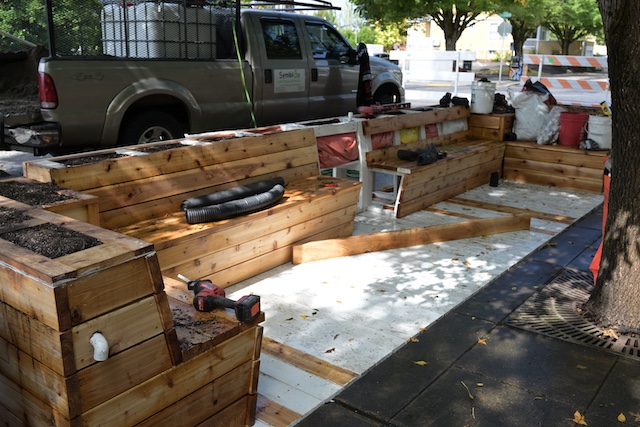
Emmett Wheatfall, who after offering his pitch-perfect poem “When the Time Comes for You to Speak,” reminded the audience of the parklet’s significance. He noted the numerous statues around the country erected to Confederate leaders and soldiers, as well as the many schools and military bases named in their honor. It was a reminder that reality and history are not synonymous. Boiled down, the reality is this: the Confederacy was an outright white supremacist fascist state which thrived on stolen land and the labor of kidnapped and enslaved Africans. Its leaders were treasonous, and in just about any other scenario, they would have been executed.
The statues, schools, bases, and numerous other sites dedicated to them are about promoting the “Lost Cause,” the idea that these Confederates were victims instead of oppressors. It’s nonsense, utterly devoid of reality. And yet the people who dismay over the toppling of effigies and the renaming of schools, spinning a yarn about the overlooked beauty of a society that in reality enslaved people as chattel, are taken seriously and regarded sympathetically by enough people that they are given space to jabber their gibberish at many media outlets.
Wheatfall, his voice gathering toward a righteous thunder, intoned, “We come not only to memorialize (Otis’s) young life, but to leave an indelible mark in the city of Portland, Oregon, wherefore as a poet I stand in solidarity that it will never, ever be acceptable or traditional to destroy the black body through the auspices of police brutality in Portland, Oregon. Never! Never again!”
Wheatfall had closed his poem with the lines:
When the moment is not about you
But someone who has died violently
Remember to reverence that moment
At that moment, a reverend is not needed
What’s needed? Just a poet.
Just a poet.
No umbrage seemed taken by Haynes, who began fighting for human and civil rights before much of the crowd was born. “This,” he intoned, ”is an institutionalized symbol that will remind generation after generation that the struggle for justice, the struggle for freedom, the struggle for being human, for human and civil rights, shall continue on.” Recognizing the parklet as a symbol of those struggles, he encouraged people to take inspiration from it as they “resist totalitarianism, police abuse, discrimination, inequality, and injustice.”
Scribes added a more time specific symbolic importance of the space, and his words echoed Wheatfall’s belief in the need for poets, and ostensibly artists of all stripes. “This piece,” said Scribes, “is unveiled today at another strange intersection in our city’s history. When lies continue to inflate the very real threat of a military siege of our city. It’s in this moment that we are seeing the potent power of story. The stories we tell about ourselves, our communities, our past, and our present do indeed shape our future. It’s impossible to ignore that the lies being told by the president and the so-called right at this moment were also popular stories about Albina for many years. An outside story was fixed on to those fuzzy borders that stretched from the Rose Quarter to over here by the Lloyd Center, splitting either side of MLK from Interstate to 42nd. It was labeled as a place of destitution, criminality. One that needed a militarized intervention. Containment. Cleanup. The police. It’s what led to 50% of all the Portland Police Bureau’s arrests happening in Portland’s Black community. It’s what supported the erosion of our home values. It’s what led to a reinvestment later that had us mostly as afterthoughts.”
Scribes closed saying, “Words matter. Stories matter. Symbols matter.”
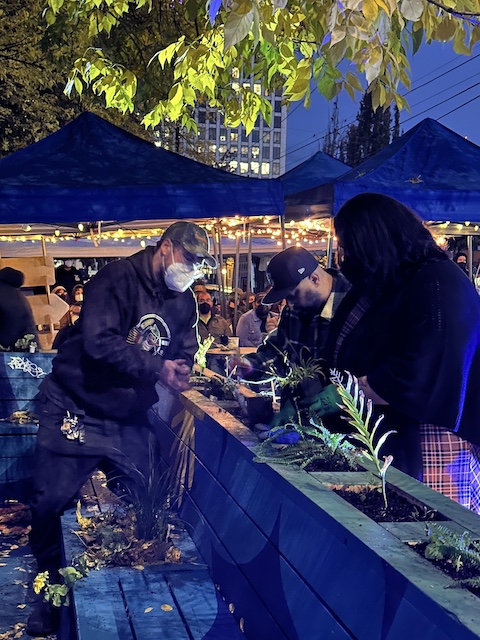
And they are informed by moments, some seemingly tiny in the grand scheme, but nonetheless a link in the chain. In light of Wheatfall’s, Haynes’s, and Scribes’s words, the ceremonial planting of two seedlings in the beds behind the benches may seem small. But when Otis’s sister Alyssa Bryant and one of his closest friends and fellow fashion artist Fabian John put them in the soil, it was the type of moment that sticks. Plants are tough. They are resilient. The pain of losing people so close to you never goes away. But people also are durable. And for the times they doubt that toughness, a strong, loving, and rooted community will be there for them.
Intisar Abioto included Keaton Otis as part of her community of artists. She read her poem about Black art being implicitly about resistance. “When I think about Keaton Otis and artists of our generation…I feel our energy is still being carried forward….I can’t write an end to this because we continue. We continue. We continue. We here. We goin’, and we comin’. We continue.”
Intisar closed with a blessing, saying Otis’s and Bryant’s names, all responding, “Ashay.” Or is it “Ase,” both pronounced ah-SHAY. According the urbandictionary.com, Ashay is “a word used in African American culture to mean ‘and so it is’ or ‘Amen.’” Perhaps its roots lie in the latter, the Yoruban word meaning “life force.” The word also has Sanskrit and Hebrew roots, meaning “blessing” or “hope.”
However one parses it, the memorial parklet is. Its life force is a community that remains fighting for justice for Keaton Otis, Fred Bryant, and all victims of police violence. It feeds off the hope that a more just world is possible, and it is worth fighting for.
Alyssa Bryant expressed her profound appreciation for the project, saying, “It’s remembering them in a positive way.” She then introduced her son, Keaton Otis’s nephew, Fred Bryant’s grandson.
“Looks just like my dad.”
The vigil demanding justice for Keaton Otis, Fred Bryant, and all victims of police violence is held on the 12th of every month, from 6-7 PM, at the corner of NE 6th and Halsey.

